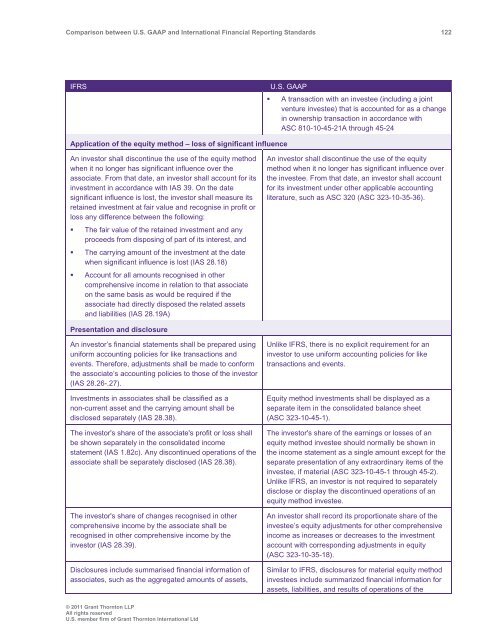Comparison between U.S. GAAP and International ... - Grant Thornton
Comparison between U.S. GAAP and International ... - Grant Thornton
Comparison between U.S. GAAP and International ... - Grant Thornton
You also want an ePaper? Increase the reach of your titles
YUMPU automatically turns print PDFs into web optimized ePapers that Google loves.
<strong>Comparison</strong> <strong>between</strong> U.S. <strong>GAAP</strong> <strong>and</strong> <strong>International</strong> Financial Reporting St<strong>and</strong>ards 122<br />
IFRS<br />
U.S. <strong>GAAP</strong><br />
• A transaction with an investee (including a joint<br />
venture investee) that is accounted for as a change<br />
in ownership transaction in accordance with<br />
ASC 810-10-45-21A through 45-24<br />
Application of the equity method – loss of significant influence<br />
An investor shall discontinue the use of the equity method<br />
when it no longer has significant influence over the<br />
associate. From that date, an investor shall account for its<br />
investment in accordance with IAS 39. On the date<br />
significant influence is lost, the investor shall measure its<br />
retained investment at fair value <strong>and</strong> recognise in profit or<br />
loss any difference <strong>between</strong> the following:<br />
• The fair value of the retained investment <strong>and</strong> any<br />
proceeds from disposing of part of its interest, <strong>and</strong><br />
• The carrying amount of the investment at the date<br />
when significant influence is lost (IAS 28.18)<br />
• Account for all amounts recognised in other<br />
comprehensive income in relation to that associate<br />
on the same basis as would be required if the<br />
associate had directly disposed the related assets<br />
<strong>and</strong> liabilities (IAS 28.19A)<br />
An investor shall discontinue the use of the equity<br />
method when it no longer has significant influence over<br />
the investee. From that date, an investor shall account<br />
for its investment under other applicable accounting<br />
literature, such as ASC 320 (ASC 323-10-35-36).<br />
Presentation <strong>and</strong> disclosure<br />
An investor’s financial statements shall be prepared using<br />
uniform accounting policies for like transactions <strong>and</strong><br />
events. Therefore, adjustments shall be made to conform<br />
the associate’s accounting policies to those of the investor<br />
(IAS 28.26-.27).<br />
Investments in associates shall be classified as a<br />
non-current asset <strong>and</strong> the carrying amount shall be<br />
disclosed separately (IAS 28.38).<br />
The investor's share of the associate's profit or loss shall<br />
be shown separately in the consolidated income<br />
statement (IAS 1.82c). Any discontinued operations of the<br />
associate shall be separately disclosed (IAS 28.38).<br />
The investor's share of changes recognised in other<br />
comprehensive income by the associate shall be<br />
recognised in other comprehensive income by the<br />
investor (IAS 28.39).<br />
Disclosures include summarised financial information of<br />
associates, such as the aggregated amounts of assets,<br />
Unlike IFRS, there is no explicit requirement for an<br />
investor to use uniform accounting policies for like<br />
transactions <strong>and</strong> events.<br />
Equity method investments shall be displayed as a<br />
separate item in the consolidated balance sheet<br />
(ASC 323-10-45-1).<br />
The investor's share of the earnings or losses of an<br />
equity method investee should normally be shown in<br />
the income statement as a single amount except for the<br />
separate presentation of any extraordinary items of the<br />
investee, if material (ASC 323-10-45-1 through 45-2).<br />
Unlike IFRS, an investor is not required to separately<br />
disclose or display the discontinued operations of an<br />
equity method investee.<br />
An investor shall record its proportionate share of the<br />
investee’s equity adjustments for other comprehensive<br />
income as increases or decreases to the investment<br />
account with corresponding adjustments in equity<br />
(ASC 323-10-35-18).<br />
Similar to IFRS, disclosures for material equity method<br />
investees include summarized financial information for<br />
assets, liabilities, <strong>and</strong> results of operations of the<br />
© 2011 <strong>Grant</strong> <strong>Thornton</strong> LLP<br />
All rights reserved<br />
U.S. member firm of <strong>Grant</strong> <strong>Thornton</strong> <strong>International</strong> Ltd
















